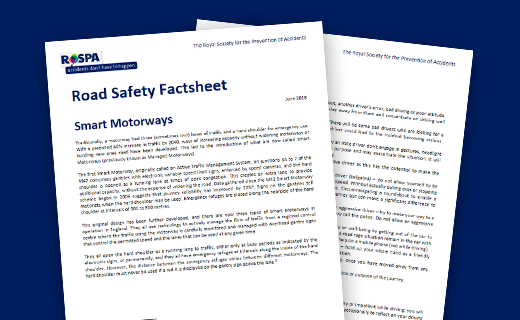Smart motorways
The Department for Transport has estimated that traffic on our road network will increase by between one-third and two-thirds in the next 30 years.Failing to provide sufficient capacity to cope with the forecast increase in traffic will increase congestion. Smart motorways were therefore introduced as a way to increase the capacity without the disruption and environmental impact of physically widening the road.
The first smart motorway was successfully trialled on the M42 in 2006, with the opening of the hard shoulder to traffic at times of peak congestion. The number of schemes has increased, and around 10 per cent of England’s motorway network is now made up of smart motorways.
There are now three types of smart motorways (previously known as managed motorways) in operation in England. These are:
Dynamic hard shoulder running
This involves opening the hard shoulder as a running lane to traffic at busy periods to ease congestion. This system is in operation on the M42, M1, M6, M4 and M5. Motorways with dynamic hard shoulder running have a solid white line; this differentiates the hard shoulder from the normal carriageway. This lane should NOT be used if a red X is displayed on the gantry sign above the lane.
All lane running
This type of smart motorway uses the hard shoulder as a permanent 'live' running lane for traffic and was first trialled on the M25. All running lanes have broken white lines, with the former hard shoulder lane only being closed in the event of an emergency.
Controlled motorways
This type of smart motorway has three or more lanes with variable speed limits controlled by electronic gantry signs, but a traditional hard shoulder that may only be used in a genuine emergency.
Motorways are statistically the safest roads in Great Britain. Despite carrying around a fifth of all traffic, motorways account for only 5% of fatalities on our roads. However, each smart motorway must be at least as safe as the traditional motorway it replaces. Data shows that whilst smart motorways have a lower fatality rate than conventional motorways, some risks would be reduced such as the risk of moving vehicle collisions, whilst the risk of live lane breakdowns are increased.
In March 2020, the Government announced that all future smart motorway schemes would be all-lane running motorways. However, the rollout of new smart motorway schemes has been paused so that there is an opportunity to collect more safety data.
At the same time, National Highways will oversee an investment of £900m to improve safety measures across the whole smart ,motorway network. The safety measures are detailed in the Department for Transport’s smart motorway stocktake and action plan. The key parts of this action plan include; the deployment of stopped vehicle detection systems; ensuring the distance between refuge areas is at a maximum distance of 1.5km, decreasing to 1km where possible; emergency refuge areas to be made more visible; automatic detection of red X violations.

